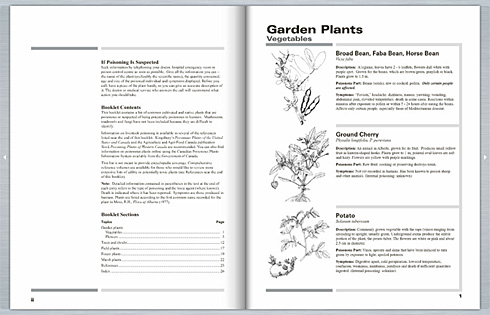| | Introduction
The word poison should suggest a warning rather than create fear. Left alone, certain plants are harmless; however, if crushed or ingested by humans, they may produce upsetting, painful or even fatal results. Certain chemicals on leaf surfaces or in plant juices may be skin irritants and induce reddening, swelling or blistering. Some chemicals effect changes leading to discoloration or light sensitivity.
Potentially irritating chemicals often accumulate in plant storage organs such as seeds and roots. Thus, a small amount of this type of tissue can contain a relatively large amount of toxin. Other plant effects are strictly mechanical and can be irritating because of punctures made by spines or thorns.
All humans can be harmed by some plants; however, the inquisitive child is particularly vulnerable because relatively small amounts of potentially toxic material can cause severe or fatal consequences in a small body. The same volume of material may have little effect on an adult.
A plant need not be eliminated from the garden just because it contains poisonous elements. All that has to be done is to teach children to keep unknown plants and plant parts out of their mouths. Make yourself aware of the potential danger of some plants and pass your knowledge on to your children.
It is impossible to predict how much of each plant needs to be ingested to cause harm because the strength of the toxin may vary with environmental conditions and a person’s response may be individualized. Also, much of the information on poisonous plants deals strictly with animals, and quantities ingested are not readily translated into human terms.
Remember too, that plants not commonly thought of as poisonous can become so if ingested in large quantities, such as onions, chives, beets, Swiss chard, borage, rutabaga, broccoli, Brussels sprouts, cabbage and turnips.
Safety Rules
- Avoid eating all plants that have coloured or milky juices such as members of the milkweed, poison ivy, spurge and poppy families. There are exceptions to all general rules; for example, lettuce has milky juice.
- Avoid all unknown white or red fruits. Poison ivy and baneberry have white fruits and are poisonous. Baneberry also has a red-fruited form. Unrecognized fruits should all be treated as potentially toxic.
- Avoid all fruits that are three-sided or three-lobed and thereby eliminate the potential dangers of spurge, horse chestnut, lily, and amaryllis families.
- Avoid eating fruits, seeds, roots and tubers of wild plants as the toxicity of plants is generally greatest in storage organs such as these.
- Avoid all bulbs that do not smell like onions or garlic. Bulbs from members of the lily and amaryllis families can be fatal if eaten in large quantities.
If Poisoning Is Suspected
Seek information by telephoning your doctor, hospital emergency room or poison control centre as soon as possible. Give all the information you can – the name of the plant (preferably the scientific name), the quantity consumed, age and size of the poisoned individual and symptoms displayed. Before you call, have a piece of the plant handy, so you can give an accurate description of it. The doctor or medical service who answers the call will recommend what action you should take.
Booklet Contents
This booklet contains a list of common cultivated and native plants that are poisonous or suspected of being potentially poisonous to humans. Mushrooms, toadstools and fungi have not been included because they are difficult to identify.
Information on livestock poisoning is available in several of the references listed near the end of this booklet. Kingsbury’s Poisonous Plants of the United States and Canada and the Agriculture and Agri-Food Canada publication Stock Poisoning Plants of Western Canada are recommended. You can also find information on poisonous plants online using the Canadian Poisonous Plants Information System available from the Government of Canada.
This list is not meant to provide encyclopedic coverage. Comprehensive reference volumes are available for those who would like to review more extensive lists of edible or potentially toxic plants (see References near the end of this booklet).
Note: Detailed information contained in parentheses in the text at the end of each entry refers to the type of poisoning and the toxic agent (where known). Death is indicated where it has been reported. Symptoms are those produced in humans. Plants are listed according to the first common name recorded for the plant in Moss, E.H., Flora of Alberta (1977).
E-Book
Poisonous Outdoor Plants is available as an e-book.
Click here to open.
Also available as a downloadable PDF (874 Kb)
|
 |
 |  |
|
|